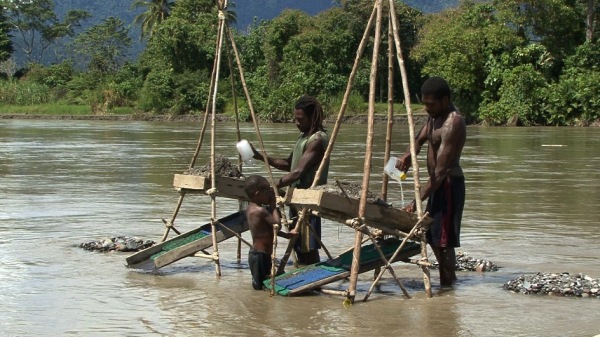
TAYAW DANCE. Photo courtesy of Shar Balagtas and Susan Corpuz
More than 100 indigenous women and women’s rights advocates in Brgy. Didipio in Kasibu town dance the Tayaw to protest the mining operations of OceanaGold Philippines
Mavic Conde | Rappler | March 07, 2020
“Tayaw,” a traditional dance of the Tuwali tribe in Nueva Vizcaya, is about unity and the power to face threats against a community.
On Friday, March 6, more than 100 indigenous women and women’s rights advocates in Brgy. Didipio in Kasibu town in this province danced the Tayaw to protest the continuing mining operations of Australian-Canadian company OceanaGold Philippines, Inc (OGPI).
Among the Tuwali women who danced was Myrna Duyan, who called the action “a dance of our lives.”
With this dance, “What we are fighting for is our life and our children’s future. Mining has destroyed our way of living. They have destroyed our sources of food and water,” Duyan said.
“To mark International Women’s Day, we dance, we protest, and we say – no more mining. OGPI has to leave,” she said as the leader of the community organization, Bileg Dagiti Babbae (Power of Women).
According to LILAK (Purple Action for Indigenous Women’s Rights), “the Tuwali women have led the movement against the destructive gold mining of OGPI for almost two decades. They now guard the picket-line in Sitio Verona, Brgy. Didipio where they maintain a round-the-clock schedule.”
LILAK added the community set up the barricade several months ago to prevent the entry of mining equipment following OGPI’s permit expiration. The women, armed only with placards and streamers bearing their calls to end mining, have successfully faced against ten-wheeler trucks and backhoes.
Expression of struggles, aspiration, and support
The “Tayaw” dance has 3 main movements, with each move representing unity, power, and freedom.
The women also held a “Gopa”, a Tuwali ceremonial chant that told the interwoven stories of their past and the future they are fighting for. The Gopa told the women’s decades-long struggle against mining and told a story of a future where they are finally freed from it.
The Tuwali women were joined by support organizations such as LILAK and Alyansa Tigil Mina (ATM), Didipio Earth Savers Multi-purpose Association Inc., (DESAMA), and Samahang Pangkarapatan ng Katutubong Magsasaka at Manggagawa Inc. (SAPAKMMI).
“As women, we understand the indescribable pain when you witness your land being destroyed and poisoned, the land where you come from – the land where you grow food,” said Mary Ann Forton, a member of LILAK and an Iraynon Bukidnon indigenous woman from Antique.
“As indigenous women, we are one with the Tuwali women in this fight for the land and against mining,” she added.
Strengthening the women’s movement
According to Judy Afan Pasimio of LILAK, joining the action of the Tuwali women for Women’s Day is staying true to its origin.
She said, “International Women’s Day has its roots from the march of thousands of women to demand their right to vote. More than a hundred years later and women are still fighting for their rights. It is important that we continue to strengthen the women’s movements as we fight for our rights and freedoms. On this day, we join the Tuwali women in their fight for their land and their life against OceanaGold.”
“We call on DENR (Department of Natural Resources) to cancel the mining permit of OGPI. They must never be granted another renewal of their mining license; else we allow another 25 years of destruction and violations of human and environment rights. Enough is enough,” said Caryl Pillora of ATM.
2018 report slams OceanaGold
Mining Watch Canada and the Institute for Policy Studies supported this call, as its 2018 report found “not only of lack of compliance, but also of unacceptable impacts of OceanaGold’s Didipio copper and gold mine on water, forests, land, indigenous peoples, human rights, biodiversity, and workers’ rights” because of the following:
- No social license to operate, nor the Free Prior and Informed Consent of the Indigenous Peoples in Didipio;
- Depletion of groundwater;
- Contamination of surface water;
- Failure to comply with commitments made in a 2013 Memorandum of Agreement (MOA) with the community;
- Labor rights; and
- Security/Red-tagging.
In a separate statement in 2018, Mining Watch Canada said OceanaGold’s November 2018 response to their report “does not address, let alone refute, the critical findings in our October 31 report: OceanaGold in the Philippines: Ten Violations that Should Prompt Its Removal.”
Mining Watch Canada’s secondary statement thus reiterated calls by local affected community members, including indigenous Ifugao peoples and the provincial and national organizations that support them, for the president and the DENR secretary to act on OceanaGold’s mining license. (READ: Environment group hits Oceanagold for operating without gov’t contract)
“OceanaGold’s 25-year mining license ends in June 2019. The Philippine government can – and should – deny the mining company’s request for a renewal. So too should OceanaGold’s requests for new exploration permits in the Philippines be denied,” it said.










